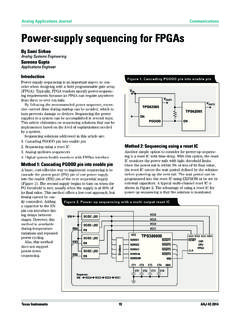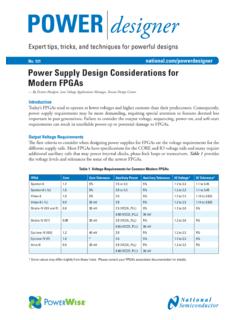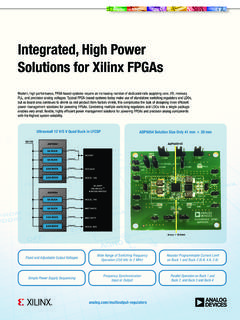Transcription of Practical Power Solutions - Analog Devices
1 Point-of-Load Power Practical Power Solutions 1. Point-of-Load Power 2. System Power Management and Portable Power 3. Power for Mixed Analog /Digital Systems 4. Hardware Design Techniques Copyright 2009 By Analog Devices , Inc. All rights reserved. This book, or parts thereof, must not be reproduced in any form without permission of the copyright owner. SECTION 1. POINT-OF-LOAD Power . Fixed Power Point-of-Load Linear Switching Regulators and Powering Powering ADIsimPower Design Technical Point-of-Load Power Fixed Power Point-of-Load Applications Today's system Power requirements have become quite challenging, and design engineers must deal with multiple supply voltages, sequencing issues, high transient load currents, thermal considerations, and many others. In most cases, these problems must be addressed at the PC board level, and not at the system Power supply . Therefore, some type of point-of-load (POL) Power supplies are required on most PC boards, even those of modest complexity.
2 This seminar is aimed at design engineers who are not Power supply experts, but must deal with the design of these POL supplies as part of their general system design projects. In this section of the seminar we will discuss some important issues relating to powering non-portable systems, focusing primarily on digital system Power (as opposed to Analog Power ). Non-portable systems are often referred to as "fixed Power " systems, and generally imply any system that does not operate on a battery. Specific issues relating to powering sensitive Analog circuits can be found in Section 3 of the seminar. This section also touches briefly on the fundamental concepts of linear and switching regulators, without delving into the detailed mathematical issues and theory relating to their design. Complete coverage of these topics can be found in textbooks as well as in online material. We believe that system design engineers are more interested in how comprehensive design tools can provide Solutions to their specific Power application problems.
3 Point-of-Load Power "Fixed Power " and "Portable Power ". Applications Fixed Power Portable Power Does Not Require Battery Requires a Battery to Operate (except for "keep alive" Notebook Computers functions) Handsets Desktop Computers Handheld Electronics Base Stations Servers For the purposes of this seminar, system Power applications are divided into two broad categories: fixed and portable. "Fixed" Power applications are those that do no require a battery (except for "keep alive" or memory backup functions). Portable Power applications require a battery for operation. Although there is much commonality in powering the two types of systems, portable systems have certain specific requirements relating to efficiency, size, cost, and weight. The issues important to portable systems are covered in Section 2 of this seminar. Point-of-Load Power Power Distribution System-1. (Down We Go in Voltage). Power Plant Transmission Lines, Substations Reduce the Voltage 1000's of Volts to 100's of Volts Utility Transformers Which comes out of your That connects to a system Produce 120/240 VAC wall outlet Power supply This figure illustrates how Power is distributed from the Power plant to the system Power supply .
4 Power from the Power plant is distributed to the substations over high voltage transmission lines at 1000's of volts. Since the product of the voltage, V, and the current, I, at any point in the system is constant (P = V I), the use of high distribution voltages reduces the current flow through the lines and hence the I2R losses. For a given amount of transmission line resistance, it is always more efficient to transmit Power at voltages which are as high as Practical . The substations reduce the voltage to 100's of volts, and utility transformers reduce the voltage for home or business to 480 V, 240 V, or 110 V. The same principle of Power distribution is applicable to the system Power supply as shown in the next figure. Point-of-Load Power Power Distribution System-2. (Down We Go in Voltage). That provides some Which powers a POL Power Converter that moderately low voltages at produces < Vout < its output Connector That powers the processor or other Power -hungry device A desktop computer Power supply is a good example of a "fixed" Power application.
5 The Power supply converts the ac line voltage to a number of common individual voltages which are distributed from the Power supply to the various PC boards in the system. This figure shows common distribution voltages of V, 5 V, and 12 V. Devices in the system often require other regulated voltages, however, such as the core voltage for the processor. This voltage can be V, V, V, V, V, etc. This requires a point-of-load (POL). regulated supply on the PC board specifically designed for the core voltage, which may be 10's of amps. The specific processor requirements often dictate other Power supply requirements, such as load transient recovery, standby modes, etc. The processor generally requires additional POL regulated voltages for the input/output (I/O) interface, and perhaps other auxiliary voltages. Flexibility in the various voltages is important because of the trend toward ever faster, smaller geometry processes which require correspondingly lower core voltages.
6 One can easily see that it is both impractical and inefficient to generate these multiple voltage rails within the system Power supply , and that POL regulation provides the best solution. In addition, local regulation generally provides "cleaner" voltage rails which is particularly important with low core voltages. Point-of-Load Power Fixed Power Signal Chain Functional Blocks 48V 12V MULTIPHASE >25A. ISOLATED CONTROLLERS. AC-to-DC. DC-to-DC. Power supply . Power supply 12V 5V. HOT SWAP. CONTROLLER 48V SINGLE PHASE. HOTSWAP SWITCHING CONTROLLER REGULATORS/. CONTROLLERS COMMUNICATION. I2C, PMBus, LOW DROPOUT LINEAR. MONITORING, REGULATORS. SEQUENCING, (LDOs). THERMAL MARGINING, MANAGEMENT, SUPERVISORY FAN CONTROL RESET GEN. SWITCHED. CAPACITOR. REGULATORS. This figure shows the typical functional blocks in the signal chain of a modern fixed Power system. The POL supplies can be either LDOs, single, or multiphase switched controllers, depending on the current output and efficiency requirements.
7 The switched capacitor (also called charge pump, or "inductorless") regulator is also shown, but is more often associated with portable systems. (See Section 2 for further discussion of switched capacitor regulators). In addition to the POL regulators, there are also important auxiliary functions such as monitoring, sequencing, margining, and supervisory functions, such as Power -on reset generators. Thermal management and fan control is also an important part of modern Power designs. For telecommunications and server applications, hot swap controllers allow PC boards to be exchanged under Power -on conditions. A typical fixed Power system may consist of some or all of the above functions, depending on the complexity and type of system. Point-of-Load Power Intermediate Bus Structure and Point of Load Regulation Offer Flexibility and Efficiency POINT OF LOAD. 48V LOSS 12V LOSS 5V LOSS 10A. 12W. DC-to-DC.
8 DC-to-DC. 95% DC-to-DC. 95%. EFF. 95%. EFF. EFF. PROCESSOR. CORE VOLTAGE. WIDER TRACES TO. HANDLE INCREASED. CURRENT. 48V 12V 5V. BUS BUS BUS. The use of intermediate bus structures and POL regulation offers both flexibility and efficiency as shown in this figure. The path from the 48 V bus to the V processor core is highlighted. In this example there are intermediate bus voltages of 12 V and 5 V which are distributed to other parts of the system. It is assumed that the efficiency of each dc-to-dc converter is 95%. The Power losses in the individual converters are shown. The only path shown is that for the processor core voltage. Additional currents supplied by each intermediate bus are not shown. In order to maintain the same voltage drop in the PC traces, the trace width should be proportional to the amount of current carried. Note that POL regulation and the use of the intermediate bus architecture allow a short trace for the 10 A processor core current because the regulator is located close to the processor.
9 Further discussion of PC board layout issues can be found in Section 4. Point-of-Load Power Two Popular Methods of Regulation: Linear and Switching (A) (B). LOW DROPOUT LINEAR REGULATOR (LDO) STEP-DOWN (BUCK) CONVERTER. PLOSS = (VIN VOUT) IIN VREF. PWM. IOUT IIN +. IIN IIN IOUT. VOUT. VOUT. VIN VREF L. VIN. COUT. + +. + LOAD D LOAD. CIN CIN. COUT. PIN POUT. VIN IIN VOUT IOUT. VOUT. EFFICIENCY VIN EFFICIENCY 100% (IDEAL COMPONENTS). There are basically two types of POL regulators: linear and switching. The linear regulator is the simplest type but generally the least efficient. However, linear regulators do not produce switching noise and ripple and are therefore useful in supplying Power to sensitive Analog components. The Power loss in a linear regulator is equal to the output current times the voltage dropped across the pass element (as shown in A). The efficiency is equal to the ratio of the output voltage divided by the input voltage, neglecting internal losses in the regulator, which should be relatively low.
10 Switching regulators, such as the buck (step-down) converter shown in B, transfer energy from input to output via an inductor that has the voltage polarity across it switching at a high frequency. If the circuit elements are ideal, the input Power equals the output Power , and the converter is 100% efficient. Regulation of the output voltage is achieved using a feedback loop which controls the duty cycle of the pulse width modulator (PWM), which in turn controls the on-time and off-time of the switching element, and hence the amount of energy transferred to the load. Most popular switching regulators are based on magnetic elements, however the switched capacitor (or charge pump) regulator is often used in low current portable applications where the current requirement is less than approximately 200 mA. This type of regulator is discussed in more detail in Section 2. Point-of-Load Power Linear Regulators vs.












